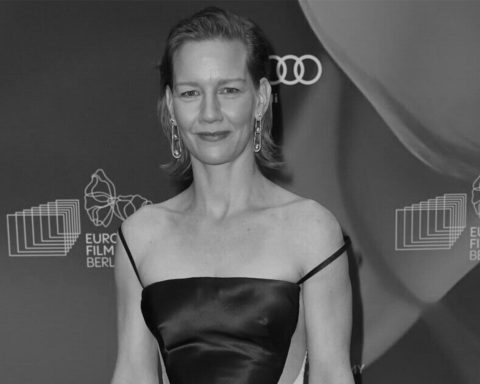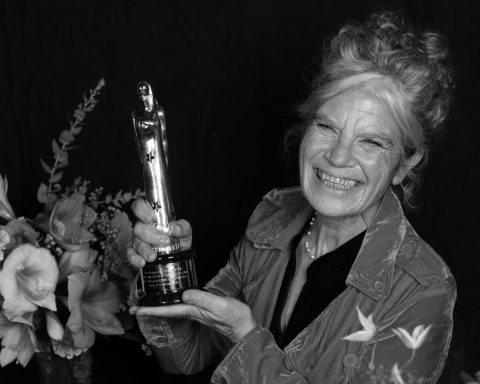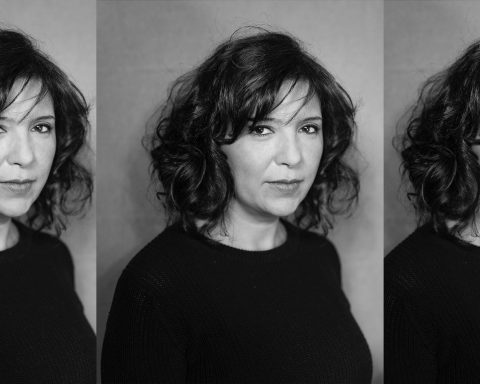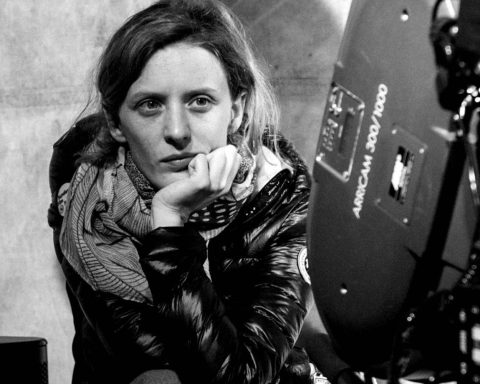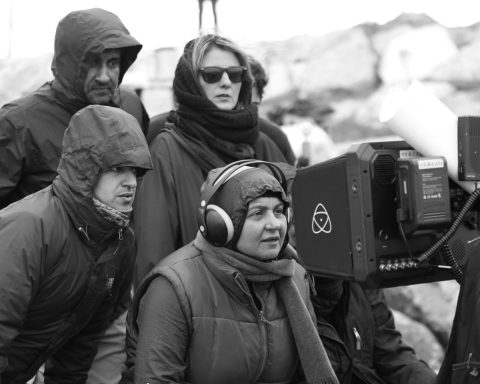Alli Haapasalo is a Finnish film director and screenwriter. She received critical acclaim for writing and directing “On Thin Ice,” her thesis film for New York University’s famed film school Tisch School of the Arts. This mercenary story won several awards in the United States and was nominated for Prix Europa in 2012.
Tara Karajica talks to Alli Haapasalo about feminism and film and her latest feature, “Girl Picture,” a bombastic and fresh depiction of girlhood in a visually compelling coming-of-age story. The film premiered at the 2022 Sundance Film Festival, where it won the World Dramatic Competition Audience Award and is now screening in the Europe! Voices of Women in Film program at this year’s Sydney Film Festival.
How did you get into filmmaking?
Alli Haapasalo: As a child, I was always directing different performances with my friends and classmates. I had a lot of creative interests all through childhood and adolescence – photography, music, visual arts, theater – and I spent most of my free time watching films – everything from Westerns to European arthouse, from black & white Finnish classics to American mainstream. By the time I was graduating from high school, I had come to realize that all my interests would come together perfectly in filmmaking. So, it was not a specific moment or inspiration, but a long journey into wanting to make films.
How did Girl Picture come about?
A.H.: Screenwriters Ilona Ahti and Daniela Hakulinen approached me with a treatment already in 2014. I got attached immediately because it was evident that they had a very fresh take on a story about adolescence. We shared the experience of loving film, but were frustrated with how few identifiable female characters we could name. It became a mission to create a story that young women of today could identify with. We developed the script a few years amongst just the three of us, before we found the right producers, Elina Pohjola and Leila Lyytikäinen at Citizen Jane Productions in 2017, and the film was greenlit in 2020.
Girl Picture is a coming-of-age story about girlhood with a fresher take on how young adults are seen and perceived on the screen, while at the same time deftly eschewing stereotypes not only of the coming-of-age genre but also the representation of young women in film, challenging the gender bias and painting a realistic picture of young women in their most authentic light. Can you comment on that?
A.H.: We are all very accustomed to seeing female characters who are one-sided, often fulfilling a functional role in the story. And, we are, of course, very used to seeing girls and women as objects of desire. I think that even when women are subjects, they are often quite distant, perhaps mysterious, sometimes etheral – more fantasies than realistic people. And what’s even worse, very often the women who are active subjects get punished in the story for being active. A good example is the often repeated narrative of “girl as victim.” We are so used to seeing women ending up dead, harmed or in danger, that many viewers have told me they watched the film constantly expecting something bad to happen to the characters. We are almost conditioned to expect a punishment for female characters who desire, or party, or wear a miniskirt or really just take center stage in their lives. And I’m definitely not saying that we shouldn’t deal with the dangers of female life on screen as well, but in this film we didn’t want to enforce and normalize that imagery anymore. In Girl Picture, the girls don’t face any danger. No one is punished, shamed, patronized or warned. I’m well aware of the fact that the world isn’t like that to most girls. But I hope that choices like this on the big screen can help create change in the real world too.
Your previous works also revolved around themes of womanhood. In that sense, there is an undercurrent feminist mission in Girl Picture, an important aspect thereof being what we say about girl as you have already stated. Can you elaborate on that? Moreover, can you talk about the message of the film, its place and impact in a post #metoo world?
A.H.: I have now seen the film with different audiences from Sundance to the Berlinale and from BFI Flare to small town Finland. The one thing that women all over have an emotional response to is seeing themselves on the big screen. Many have told us that they feel seen for the first time. One audience member wrote that this feels like a movie she had been waiting for all her life. This response leaves me very happy about us having been able to reach the goal of representing girls in a more complex and relevant way. But it also leaves me angry. How is it, that a woman in 2022 can feel like they have not been represented in films before? In the post #MeToo world, we have luckily gotten pretty far in the conversation about who gets to tell stories and whose stories we are telling. But we still have decades of underrepresentation to compensate for. There is an enormous need to diversify film. And not just gender diversity, but also diversity or race, class and sexual orientation.
Emma, Mimmi and Rönkkö are not just young girls, but first and foremost human beings. Even though they are still growing up and figuring out who they are, they are still complex individuals with needs and desires, and they aren’t ashamed to express themselves. Can you talk about the characters? How do you see them? Can you talk about the portrayal of young women in Girl Picture?
A.H.: Mimmi, Emma and Rönkkö are seventeen or eighteen, an age that I call a liminal age, because at that age, you’re basically constantly fluctuating between adulthood and adolescence. There is an enormous amount of urgency in pretty much everything – emotions are wild, and proportions are out of whack because you don’t have much perspective yet. They are all trying to draw their own contours in different ways. For Mimmi, it means navigating between her strong independence and the need to still feel like a child in Mom’s arms. For Rönkkö, it means trying to find sexual pleasure, which she hasn’t experienced yet. And for Emma, it means seeing her life’s first passion, figure skating, in a new light, when a new passion in the form of Mimmi, enters her universe. One thing that was key in the portrayal of young women was embracing imperfections – both inner and outer ones. Concretely, it meant that we show girls with acne, hairy armpits and dirty hair. But moreover it meant that the girls are everything from wonderful to mean, from insecure to emphatic, from unfair to supportive and many other things. And, making a claim that no one – young or older – is somehow ready or complete as a human being. Rönkkö’s quest for pleasure is not resolved by her finding a guy who finally gives her pleasure. The answer isn’t in the other person, it’s in accepting yourself the way you are.
It’s important to note that my agenda to portray girls in a new light doesn’t mean portraying them in just a good light – I’m not here to create just some wonderful female characters! I’m interested in stories of complex human beings, with all their flaws, and of any gender.
The film is told from the perspectives of Mimmi, Rönkkö, and Emma, instead of just focusing on one point of view. Can you delve into finding the balance in the interwoven narratives of these three characters?
A.H.: It was definitely a big challenge in the writing process to find the perfect balance. On the one hand, you have the A plot of Mimmi and Emma falling in love and the B plot of Rönkkö going on a quest for pleasure. On the other hand, it’s Mimmi and Rönkkö, who are best friends bringing the two plots together. And then, there is the subplot of Emma’s ice skating career to weave in. The discovery of the structure of three consecutive Fridays was decisive. When Ilona and Daniela composed the draft where the whole story takes place on these three Fridays – and the Saturday following the last Friday –, things started to fall into place. And, in the editing room, I didn’t struggle with the balance at all anymore.
Girl Picture is a celebration of female friendship as well as an exploration of love and romantic satisfaction. Can you comment on exploring both platonic and romantic love, satisfaction, but also the search of female identity?
A.H.: I’m tired of female sexuality often seen through a very male perspective. I’m equally tired of female sexuality being quite over the top in cinema. It was key for me that in this film sexuality is seen a normal, positive, sometimes problematic part of life, and everyone should be allowed to explore it safely. Girls are sexual beings too, and they don’t deserve a punishment for desiring, nor should they be made to feel ashamed for it. The story of Emma and Mimmi is a love story of two girls, but sexual orientation is never mentioned in the film. We didn’t want any elements of a coming out story. I don’t want to belittle the need and importance of those, but similarly to the narrative of “girl as victim” I think we have seen a lot of the “gay as victim” narrative. If the narrative we enforce in film is that being gay is always a problematic thing – for either the character or for someone else in the story –, we are enforcing a gruesome representation of what it means to be gay. It’s time we moved past seeing a queer relationship just about the fact that it involves people of the same sex. A love story is about people who fall in love, not about their sexual orientations. Rönkkö’s storyline deals with asexuality, a topic not often seen in film. In the end, we don’t know if it’s asexuality or lack of connection that’s causing her not to feel pleasure during her sexual encounters. It’s safe for her to explore, and, as the film ends, the exploration continues. In her intimate scenes with the opposite sex, you can notice that consent is always confirmed, and that doing so is natural and easy. As for the friendship of Mimmi and Rönkkö, we wanted to emphasise how girls can be amazingly emphatic and encouraging with each other. I feel like quite often female friendship is depicted with a lot of animosity, and we wanted to do the opposite. What women need is solidarity, and the power of female friendship is a superpower.
Aamu Milonoff, Eleonoora Kauhanen and Linnea Leino are very natural in their roles. Can you talk about the casting and shooting processes?
A.H.: I knew the film would live or die with the three leads, so I gave myself a lot of time for casting. I wasn’t just looking for three talented and charismatic individuals, but really I was looking for a band that would play together seamlessly. Simultaneously with casting, I was working with my core artistic team on early plans for the aesthetics of the film, and this was really helpful in terms of casting: while the world we were creating was becoming clearer in the artistic meetings, my ideas for Mimmi, Emma and Rönkkö were also getting more concrete. After a three-month casting process, the decisions were easy, as I was totally sure that these three amazing women were the right choices. Once the leads were cast, we had an extensive rehearsal process. We broke down the script in detail, shared a lot of our thoughts and experiences of being young and rehearsed all the key scenes. We created backstories for everyone, and also made sure that we knew what had happened between all the Fridays in the film. All intimate scenes were rehearsed in a specific process with our intimacy coordinator, Pia Rickman. In addition, Linnea Leino rehearsed ice skating for three months. All this gave us the opportunity to create a mutual trust, which is the main component of filmmaking. It also made the cast become real friends, which was great for the reality of friendship on screen. Aamu, Eleonoora and Linnea all embraced the opportunity of a lot of rehearsals, and it was a very committed and collaborative process.
Can you talk about the film’s visual concept and sound design that convey abrupt changes of emotion and moods?
A.H.: The main goal in the visual concept was that the film would feel real. I kept saying to everyone that nothing should look or sound like a movie, which, of course, caused many hilarious moments, considering we were making a movie… I wanted to avoid an adult look at teenagers, or a nostalgic one, and I certainly wanted to see the girls at eye level, so that their experience would feel truthful and relevant. In an early meeting, I talked about how it feels like for teenagers that movement is the norm, and being still is a special effect. That resonated well with DP Jarmo Kiuru, and we adapted the idea into a center pillar of our camera method. Jarmo and I devised a shooting method that was drawing from the style of a verité documentary film while being well planned and thoughtfully composed. Jarmo is a very human and soulful person, which makes him a masterful camera operator, his is a sensitive and attentive eye and camera movement is a huge part of personality of the film.
Sets made by production designer Laura Haapakangas follow the same strategy. Her work doesn’t get noticed enough because she has made everything so believable and realistic! There are so many layers in the production design: the modern neighbourhoods of Helsinki surrounding the girls are being built, just like the girls are building their identities. The specificity of each character is created in the sets and in the costumes and make up. Costume designer Roosa Marttiini and make-up designer Kaisu Hölttä did an incredible job in creating the characters who have specificity and who are also in constant change. I adore this whole team.
Editor Samu Heikkilä is incredible with building the character arcs – and with rhythm. We went for the abrupt changes in tempo and mood, because adolescence is all about abrupt changes of emotion. Samu is also masterful with weaving sound in dramaturgically in the picture edit. Sound designer Anne Tolkkinen built on the dynamic picture edit and made the sound world very detailed, rich and layered, while also seemingly totally effortless.
A big topic of conversation was the tone. If you have “subtle” on one end of the spectrum and “over the top” on the other end, where should we be? Often, when we go for realism, we opt for subtle. But teenagers are not subtle! That age is all about bursting emotions the size of the universe. And, I wanted to embrace that. So, we kept encouraging each other to dare to go toward the big emotions – even pathetic ones – all along. The soundtrack created by music supervisor Jan Forsström is a great example. He found songs that are walking the tightrope of too much or just enough in many instances and I’m a huge fan. It’s always been a dream to use a lot of pop songs in a big way in a film and this film was a perfect place to do that.
How much of your own experience growing up is there in the script and the characters?
A.H.: My experiences are reflected in the view of the world that the film has. That is to say, that they are less quantifiable, but the way I look at the world and human beings is there in how the film looks at the world and human beings. Ilona and Daniela have lent more personal experiences to the film – it’s not autobiographical, but the story builds a lot on their experiences of teenage life.
What were the challenges when making this particular film?
A.H.: Bias! We are all so completely full of bias, and in the process of making this film, I learned very concretely how much it affects all the decisions we make. In the writing stages, we had to jump over many hurdles and actively unlearn our own bias. We definitely had a draft with a coming out aspect, we had a draft with a sleazy guy who puts the girls in danger. And, we had to constantly deconstruct these learned scenarios in order to have a better story. Then, in the financing stages we had to convince a lot of people to see through their bias about young girls. A story of three girls on three consecutive Fridays was definitely not a story that anyone – anyone – thought would be a Sundance winner! And then, while in production, I had to work hard on believing that this story – which was small on page, but huge in emotion – was “big enough” or “important enough” to be told. I was worried that people would say that “nothing happens” in the film, because they are not used to watching three girls’ growing pains without danger for 100 minutes! Now that the film is out, many viewers have told me that they kept expecting something bad to happen to the girls at any point. But luckily rather than finding that uneventful, they found that a big relief. The battle against bias was hard, but well worth it.
Can you talk about the title “Girl Picture,” which in Finnish is “Girls Girls Girls”?
A.H.: Both titles are trying to own or take back terms or phrases which we connect to belittling or patronizing. In Finnish “girls girls girls” is something that you hear people say with a condescending tone while wagging their finger like “what have you done now?!” Often, the word “girl” is also used to look down on women. In the beginning of the production, someone told me I should say “young women” instead of saying “girls,” but I absolutely refuse to attach belittling to the word girl! I want to take it back and use it proudly. The English title refers to both the idea of “a portrait of girls,” which I think the film is, but it also evokes the idea of “chick flick.” Historically, films – or any cultural product – geared for women have been seen as less important than the ones made for men. Putting the idea of “this is a film of girls for girls” in the title says that we don’t care about your attitude – we are tired of feeling ashamed and belittled. Having said that, this is, of course, not JUST a film for girls, but for people of any gender!
Are you a feminist? If so, how does this inform your filmmaking?
A.H.: I am a feminist, which means that I want equality for all. I see feminism as a worldview, so I guess it affects everything in the way I work. As a director, I am inclusive – I really enjoy bringing an artistic team together and working collaboratively toward a common goal. I try to break down barriers between different groups of people, and not have the camera lens divide people into those in front of the camera and others behind the camera; we are all one team. I think diversity is always an asset, so I want diverse crews and casts.
Feminism doesn’t mean being right about things. To me, it means quite the contrary: trying to be critical and analytical of your own thinking, bias and privilege. And, being aware of how your choices, coming from a position of power, affect others. As a feminist, I have to be aware of the representations I put on the big screen. When we were developing Girl Picture, some people asked me if the idea is that gender roles are reversed, as in girls taking the roles usually belonging to boys, and boys being the one-sided supporting characters. That wouldn’t be very good feminism, would it? It was important not to keep making the same mistakes, but instead try to create male supporting characters that were complex and human, just like the female ones. The same goes for racial diversity: the Finnish film industry is still predominantly white, which does’t represent the Finnish people. I think every feminist should work for a more diverse representation of Finns in film, and I am confident that now that we have been able to get more female voices heard in the industry, the next step is more voices of different races. Feminism is seeing and listening to others. A director has a lot of power, and if you want to, you can use it well. In Girl Picture, a concrete example of a feminist choice was our soundtrack. Music supervisor Jan suggested that the film would only feature female or queer artists, while cis male artists would be excluded. You will never hear or realise this while seeing the film, but in doing this, we were not only able to choose very appropriate artists for the story, but also support the work or many smaller artists, who share the values of the film. This voice was not a statement against cis males – I think they have plenty of opportunities in the world to have their music featured.
Who is your favorite female filmmaker and what is your favorite film by a female filmmaker?
A.H.: This is an impossible question to answer, as I adore and respect so many female filmmakers – from the amazing Agnès Varda or Jane Campion to the wonderful Céline Sciamma or Mia Hansen-Løve – and many, many others! There is a great film festival in Helsinki called Love and Anarchy. Last fall, I got four tickets to four films that sounded interesting – and only after purchasing them, did I realize that all were directed by a female filmmaker. I was so happy to realize that we have come to a day and age where this happened, without me having made a point about it.
There has been a lot of talk about the situation of women in the film industry these past four years. What is your take on the matter? How is it in Finland?
A.H.: I started in film school twenty-two years ago. I remember people saying then that female directors were coming to the scene. I guess there were more women studying film and getting films made than before. But then, when my first feature came out in 2016, I discovered that I was in quite a small group of female debut filmmakers at the time. There was a bubbling under the pre #metoo momentum, where women in the industry were getting frustrated about the fact that clearly there was a lot of gender bias, but no one seemed to take their complaint seriously. After #metoo, the industry finally woke up, and things started to happen. Statistics have been collected, female directors have come to make very successful films, and last year at the Finnish Film Awards, two out of three Best Director nominees were women and all of the three screenwriter nominees were women. A woman won in both categories. Next year, the Finnish Film Awards is doing away with gender-based acting awards – no more best female and male actors – and I applaud that. So, things are going in the right direction. If we want equality and diversity, it’s not just for women to push for it, but everyone’s job. Film schools, granting institutions, production companies, agencies, film foundations, film festival organisations – there is a tremendous amount of power in all of these, and everyone can take on initiatives to bring equality to the industry. I really hope that some prestigious old bastions that still feel defensive about taking initiative for gender equality will come around soon. Our audiences have made it clear that they want relevant stories that represent the world they live in, not just the world of people of privilege.
What are you working on next?
A.H.: I have two feature films in the script stages and two drama series in development. The series deal with current political topics, and the features are stories of women who are navigating their place in society and community and dealing with their relationships to sexuality and identity. I guess I’m starting to repeat myself! I haven’t ever decided that I will only make female-driven films, but there are a lot of untold stories about women’s experiences in the world, and luckily the world has opened its eyes to these stories.
Photo credits: ©Marica Rosengard.
This interview was conducted in partnership with:

and







